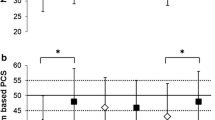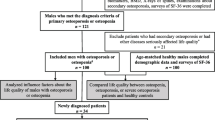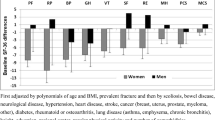Abstract
Health-related quality of life (HRQOL) in postmenopausal women with osteoporosis has hitherto been mainly assessed in patients with clinically recognized vertebral fractures. Our study aimed to investigate the QOL perception in 361 asymptomatic ambulant postmenopausal women who came to our center for an osteoporosis screening program planned with their general practitioners. The Quality of Life Questionnaire of the European Foundation for Osteoporosis (QUALEFFO) was administered to all subjects. The participants underwent bone mineral density (BMD) measurements by DXA of either the lumbar spine and/or the femoral neck, as well as X-ray examination of the thoracolumbar spine to identify subclinical vertebral fractures. According to the WHO definition, where subjects are subdivided by BMD values into three groups (women with normal BMD, osteopenia, and osteoporosis), a significant difference was found only for the domains which explore general health perception (p<0.01 by ANOVA) and mental function (p<0.001 by ANOVA). When we segregated both osteopenic and osteoporotic women according to whether or not they had vertebral fractures, a significant difference was found only in osteoporotic patients for domains which explore physical function (p<0.001), social function (p<0.001), general health perception (p<0.02), and total QUALEFFO score (p<0.01). Stepwise multiple logistic regression analysis of the whole sample showed that both vertebral fractures and a low femoral BMD impairs QOL perception, while age did not exert a significant influence. ROC curves analysis demonstrated a low discriminating capacity of individual domains and total QUALEFFO score for both vertebral deformities and BMD categorization. Our results showed that QUALEFFO is not able to discriminate between patients with or without subclinical vertebral fractures. However, some aspects of QOL appear to be impaired in patients with subclinical vertebral fractures or reduced BMD.

Similar content being viewed by others
References
Cauley JA, Thompson DE, Ensrud KC, Scott JC, Black D (2000) Risk of mortality following clinical fractures. Osteoporos Int 11:556–561
Martyn CN, Cooper C (1999) Prediction of burden of hip fracture. Lancet 353:769–770
Chrischilles EA, Shireman T, Wallace RB (1994) Costs and health effects of osteoporotic fractures. Bone 15:377–386
Minisola S, Grossi C (2002) Quality of life in patients with osteoporotic fractures. Aging Clin Exp Res 14:60–63
Gold DT (2001) The nonskeletal consequences of osteoporotic fractures: psychologic and social outcomes. Rheum Dis Clin North Am 27:255–262
Tosteson ANA, Hammond CS (2002) Quality-of-life assessment in osteoporosis: health-status and preference-based measures. Pharmacoeconomics 20:289–303
Lips P, Cooper C, Agnusdei D, Caulin F, Egger P, Johnell O, Kanis JA, Kellingray S, Leplege A, Liberman UA, McCloskey E, Minne H, Reeve J, Reginster JY, Scholz M, Todd C, de Vernejoul MC, Wiklund I (1999) Quality of life in patients with vertebral fractures: validation of the quality of life questionnaire of the European Foundation for Osteoporosis (QUALEFFO). Osteoporos Int 10:150–160
Kanis JA, Minne HW, Meunier PJ (1992) Quality of life and vertebral osteoporosis. Osteoporos Int 2:161–163
Oleksik A, Lips P, Dawson A, Minshall ME, Shen W, Cooper C, Kanis J (2000) Health-related quality of life in postmenopausal women with low BMD with or without prevalent vertebral fractures. J Bone Miner Res 15:1384–1392
Martin AR, Sornay-Rendu E, Chandler JM, Duboeuf F, Girman CJ, Delmas PD (2002) The impact of osteoporosis on quality-of-life: the OFELY cohort. Bone 31:32–36
Genant HK, Wu CY, van Kuijk C, Nevitt MC (1993) Vertebral fracture assessment using a semiquantitative technique. J Bone Miner Res 8:1137–1148
World Health Organization Study Group (1994) Assessment of fracture risk and its application to screening for postmenopausal osteoporosis. WHO Technical Report Series, No. 843. WHO, Geneva
Koçyigit H, Gülseren Ş, Erol A, Hizli N, Memis A (2003) The reliability and validity of the Turkish version of quality of life questionnaire of the European Foundation for Osteoporosis (QUALEFFO). Clin Rheumatol 22:18–23
Hall SE, Criddle RA, Comito TL, Prince RL (1999) A case-control study of quality of life and functional impairment in women with long-standing vertebral osteoporotic fracture. Osteoporos Int 9:508–515
Cook DJ, Guyatt GH, Adachi JD, Clifton J, Griffith LE, Epstein RS, Juniper EF (1993) Quality of life issues in women with vertebral fractures due to osteoporosis. Arthritis Rheum 36:750–756
Zimmerman SI, Fox KM, Magaziner J (1993) Psychosocial aspects of osteoporosis. Phys Med Rehabil Clin N Am 6:441–453
Ethgen O, Tellier V, Sedrine WB, De Maeseneer J, Gosset C, Reginster JY (2003) Health-related quality of life and cost of ambulatory care in osteoporosis: how may such outcome measures be valuable information to health decision makers and payers? Bone 32:718–724
Tsauo JY, Chien MY, Yang RS (2002) Spinal performance and functional impairment in postmenopausal women with osteoporosis and osteopenia without vertebral fracture. Osteoporos Int 13:456–460
Adachi JD, Ioannidis G, Berger C, Joseph L, Papaioannou A, Pickard L, Papadimitropoulos EA, Hopman W, Poliquin S, Prior JC, Hanley DA, Olszynski WP, Anastassiades T, Brown JP, Murray T, Jackson SA, Tenenhouse A and the Canadian Multicentre Osteoporosis Study (CaMos) Research Group (2001) The influence of osteoporotic fractures on health-related quality of life in community-dwelling men and women across Canada. Osteoporos Int 12:903–908
Adachi JD, Ioannidis G, Pickard L, Berger C, Prior JC, Joseph L, Hanley DA, Olszynski WP, Murray T, Anastassiades T, Hopman W, Brown JP, Kirkland S, Joyce C, Papaioannou A, Poliquin S, Tenenhouse A, Papadimitropoulos EA (2003) The association between osteoporotic fractures and health-related quality of life as measured by the Health Utilities Index in the Canadian Multicentre Osteoporosis Study (CaMos). Osteoporos Int 14:895–904
Author information
Authors and Affiliations
Corresponding author
Rights and permissions
About this article
Cite this article
Romagnoli, E., Carnevale, V., Nofroni, I. et al. Quality of life in ambulatory postmenopausal women: the impact of reduced bone mineral density and subclinical vertebral fractures. Osteoporos Int 15, 975–980 (2004). https://doi.org/10.1007/s00198-004-1633-2
Received:
Accepted:
Published:
Issue Date:
DOI: https://doi.org/10.1007/s00198-004-1633-2




